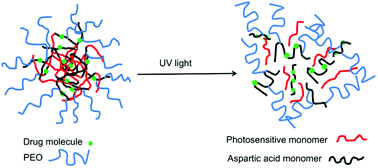Photodegradable poly(ester amide)s for indirect light-triggered release of paclitaxel†
Abstract
Stimuli-responsive micelles formed from amphiphilic copolymers are promising materials for the delivery of drugs and can potentially lead to enhanced biological properties and efficacies. Among the available stimuli, light is particularly attractive, as it can be highly localized in time and space. Described here is the development of a new fully photodegradable poly(ester amide) (PEA) backbone. Degradation in response to UV light was demonstrated by UV-vis spectroscopy, NMR spectroscopy, and size exclusion chromatography. Upon the incorporation of an L-aspartic acid-based monomer, providing carboxylic acid functional handles along the PEA backbone, the anticancer drug paclitaxel (PTX) was conjugated by an ester linkage and poly(ethylene oxide) was conjugated via an amide linkage to impart amphiphilicity. Micelles were prepared from the resulting amphiphilic copolymer and were demonstrated to break down in response to UV irradiation. This led to accelerated release of PTX, which is believed to result from the increased exposure of the ester linkages to water upon micelle disruption. The in vitro toxicities of both UV irradiated and non-irradiated micelles were also evaluated and compared to PTX in Cremophor EL–ethanol and to micelles without drug.


 Please wait while we load your content...
Please wait while we load your content...